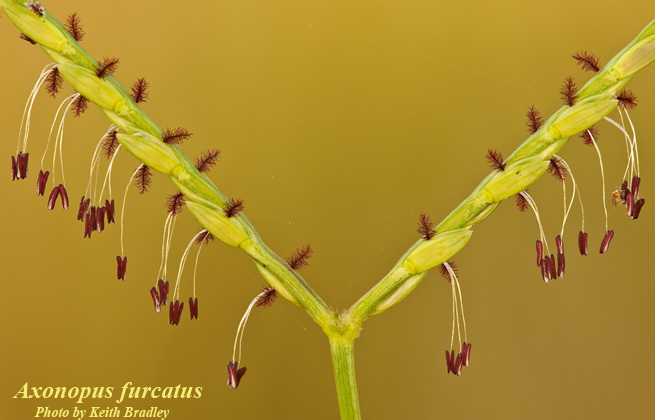Difference between revisions of "Axonopus furcatus"
(→Habitat) |
|||
| Line 1: | Line 1: | ||
{{italic title}} | {{italic title}} | ||
| + | Common names: Big carpetgrass <ref name= "USDA"> [https://plants.usda.gov/core/profile?symbol=CEAM USDA Plant Database]</ref> | ||
<!-- Get the taxonomy information from the NRCS Plants database --> | <!-- Get the taxonomy information from the NRCS Plants database --> | ||
{{taxobox | {{taxobox | ||
Revision as of 19:14, 5 June 2018
Common names: Big carpetgrass [1]
| Axonopus furcatus | |
|---|---|

| |
| Photo by the Atlas of Florida Plants Database | |
| Scientific classification | |
| Kingdom: | Plantae |
| Division: | Magnoliophyta - Flowering plants |
| Class: | Liliopsida - Moncots |
| Order: | Cyperales |
| Family: | Poaceae |
| Genus: | Axonopus |
| Species: | A. furcatus |
| Binomial name | |
| Axonopus furcatus (Fluegge) Hitchcock | |
Contents
Taxonomic Notes
Synonym: Paspalum furcatum (Flügge)
Varieties: none
Description
A. furcatus is a perennial graminoid of the Poaceae family native to North America. [2]
Distribution
The A. furcatus is found along the Coastal Plains of Virginia to Florida and west to Texas and Arkansas. [2]
Ecology
Habitat
A. furcatus can be found in maritime forests, sandy forest, bottomlands, calcareous wet meadows and other coastal regions. [3]
This grass is most abundant in regions burned in the winter. [4]
Conservation and Management
Cultivation and restoration
Photo Gallery
References and notes
- ↑ USDA Plant Database
- ↑ 2.0 2.1 USDA Plant Database
- ↑ [Weakley, A. S. (2015). Flora of the Southern and Mid-Atlantic States. Chapel Hill, NC, University of North Carolina Herbarium.]
- ↑ [Boughton, E., et al. (2013). "Season of fire and nutrient enrichment affect plant community dynamics in subtropical semi-natural grasslands released from agriculture." Biological Conservation 158: 239-247.]